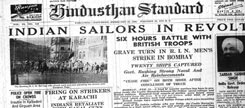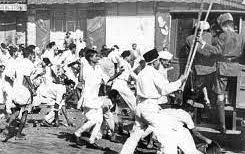Communism in India, Learning from History here ♦ Sailors United here ♦ Organizing for Communism in the Military here ♦
Communism in India: Learning from History
INDIA April 13th, 1919, marked the beginning of a communist movement in South Asia. Thousands of restive unemployed workers and youth had assembled in Amritsar (Punjab) as food prices skyrocketed and high inflation left many destitute and hungry. The British Brigadier General Dyer was asked to take a ‘tough stand.’
The imperialist war in Europe had ended. Over 400,000 Punjabi soldiers, recruited by the British Army to defend British imperialism, were returning. They had joined the army because villages could not sustain small farms. Now they added to the already high unemployment.
Many unemployed were forced to find work in East and South Africa, the West Coast of California, Canada, and Latin America. Some expatriate Indians saw the need to overthrow British rule. They faced racist segregation in California and Canada had passed ‘exclusion’ laws banning people from India.
The Ghadar (“Revolt”) Movement had started in San Francisco and Oregon in 1914 following the outbreak of World War. Its leaders incited the Indian army to rebel against colonial rule and smuggled arms to India. They carried out 42 unsuccessful mutinies, but Punjab became a revolutionary hotbed. Communist and socialist circles sought alternatives to British rule.
General Dyer, known for his brutality, arrived in Amritsar on April 13, 1919. Some 15,000 to 20,000 people had assembled in a huge courtyard, Jallianwala, surrounded by narrow lanes and only one gate. They were protesting the beginning of the Spring harvest season because most of the grain was transported to England.
General Dyer ordered 40 of his troops to shoot at the crowd. The massacre lasted for 10 minutes, until no bullets were left. With every exit guarded, 1000 or more died. Hundreds fell to their death in a well to escape bullets.
The aftermath of the Jallianwala saw an unprecedented revolutionary outpouring. The Indian National Congress (led by Gandhi) offered reform, religion, and pacifism. The masses wanted a complete change, no religion, and an armed struggle. “No Pundits, No Mullahs,” the masses cried. Marx’s works, especially The Communist Manifesto, began wide circulation.
One revolutionary, the landless laborer Udham Singh, struggled to find work after the war. When he was seven, his father had collapsed and died of hunger. Singh spent his youth in an orphanage and got radicalized. He joined the British Army in Basra, Iraq. He was trained in the use of ammunition and maintenance, considered the lowest-status job. He joined the Ghadar movement and eventually, Indian Workers Association. Aided by fellow revolutionaries in London, he assassinated the commander who reported to Brigadier Dyer.
Assassinations aren’t revolutions, but Udham Singh is a household name in Punjab. Inspired by the Bolshevik revolution, young Indian revolutionaries matured in their ideas. The 1920s saw huge rebellions of workers, soldiers, and peasants against British rule. Six revolutionaries formed the Communist Party of India in 1925.
The Communist University of the Toilers of the East (KUTV), formed in Moscow in 1921, trained young revolutionaries in dialectical materialism, history, and communism. Many KUTV students, including the CPI founders, helped to spread communism around the world.
Lessons for Today
Twentieth-century communists fought for socialism, thinking it was a path to communism. But, as we elaborated in Mobilize the Masses for Communism, socialism inevitably led instead to full-blown capitalist wage slavery in Russia, China, and elsewhere.
Still, past revolutionaries give us guidelines for our future. Their exemplary sacrifice, resilience, and reliance on the masses force us to see that only communism can end the capitalist system of endless brutality. A communist society without money is the answer to capitalist profit and murder.
We also learn that a small party, with the correct outlook, can mobilize the masses for communism. Rising unemployment today puts millions of youths worldwide into the bosses’ armies. It gives us an opportunity to use their weapons to destroy our class enemy.
This is the message we bring on May Day: To organize, recruit, read, and write for Red Flag!


In February of 1946, a group of Hindu and Muslim naval ratings (enlisted sailors) decided to go on a strike due to lack of food. For the first time there was a unity of the Hindu and Muslim naval ratings.
It spread from one ship to another. The British ruthlessly suppressed the mutiny. But there was overwhelming support from the masses in Bombay (now Mumbai). The workers collected food and provided first aid to the wounded. The mutiny spread quickly from Karachi to Iran and as far away as Indonesia. The Congress Party and the Muslim League condemned the mutiny. Only the Communist Party of India supported it.
India: Organizing for Communism in the Military
Today’s intensifying military conflicts make me think about communist revolution as the only solution for the international working class. I am an ex-soldier in the Indian military. I work in the auto industry in Chennai.
It appears impossible to even think about building communism in the military. There is intense nationalism. Every day the rulers push anti-Pakistan and anti-China rhetoric. Muslims are killed for every possible excuse.
I was very young and politically unaware when I enlisted. Almost everybody was like me. We joined because in the villages there were no jobs. My father lost his piece of land.
The military told us that they will be defending India against Pakistan and China. There were patriotic songs, music, and slogans. I only knew that we would be facing an enemy very soon.
We were all recruited from Tamil Nadu in south India. The only language I speak is Tamil. We were sent to the northern state of Chhattisgarh. They speak different languages. We could not understand a word of it. Our officers said we were there to combat militants who attacked police stations and blew up power stations.
I saw that the people who had taken up arms were a rag-tag army. I was astonished to see women combatants, unheard of in the Indian army. I spent six months there, combing the villages and blowing up homes of people I did not know. When there was news of dead enemy combatants, our superiors rewarded us.
Seeing comrades getting killed or severely injured, I started to question who we were fighting for. I saw that the so-called combatants were people just like me. They lived in poverty. I also discovered that they were among the tribal people called the Adivasis. They lived in the jungles because their land was uprooted for mines and minerals owned by people who did not set foot in the jungles. We were supposed to defend the rich and fight the poor.
Exploding Indian Army’s Divisive Lies
I was not the only one asking questions. I found that the Indian military is based on casteism, racism, and language differences. They sent us to the north because we did not speak the same language and had a different caste.
Other army units were sent to the northern Himalayan border areas because we did not speak the language and looked different. The local people, Gurkhas, are recruited and sent to suppress industrial strikes in areas where they don’t speak the language. When people speak a different language, they look different, it is easier to fight them. But these lies explode as the soldiers discover that they are fighting to defend the rich capitalists.
Comrades stationed in the Himalayas discovered that it was like a different planet. They were camped at an altitude of 20,000 feet. They faced severe cold of -20⁰C (-4⁰F), snow, ice, and avalanches. Almost 30% of them died due to extreme weather. More died when they were sent to lower elevations due to sudden changes in blood pressure. They were told they would fight the Chinese army, but they did not see a single Chinese soldier.
Change ICWP to Take on the Capitalist Enemy
The capitalists will only sacrifice more of us in the pursuit of profit. They might appear invincible but war and combat change everything. The most patriotic people question everything. That is our opportunity. We can do it now. We don’t have to wait for war or where there are already wars.
The capitalists are gearing up for more wars because capitalist competition leads to world war. They are also exposing their extreme weakness and instability. They rely on the workers and soldiers to save them. Our job is to do the opposite.
I can contribute to the formation of an ICWP military collective. We will think about how to implement our ideas to recruit red soldiers in service of the international working class.
—Comrade in India


